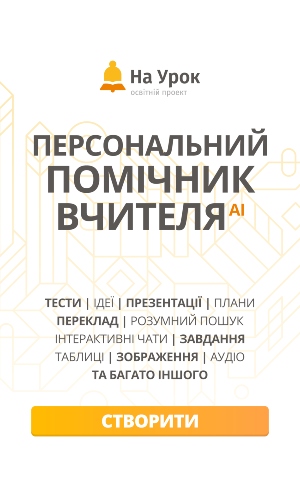Урок англійської мови. Розділ 4 Урок 1 "Ми щасливі" 2 клас
Unit 4. We Are Happy!
Lesson 1
Тема: Ми – щасливі!
Мета:
навчальна: ознайомити з новими лексичними одиницями, введення їх у мову, активізувати вивчений лексико-граматичний матеріал, розвивати вміння та навички читання, письма, усного мовлення, вдосконалювати компетенції читання, аудіювання й усного монологічного мовлення;
розвиваюча: розвивати інтелектуальні та пізнавальні здібності, різні типи пам’яті – слухову, зорову, оперативну, тривалу, увагу, учити працювати у парі, вчитися логічно висловлювати думку;
виховна: виховувати культуру співбесіди, риси характеру, як доброзичливість, толерантність, активність, культуру спілкування, виховувати зацікавленість у розширенні свої знань.
Обладнання: картки та плакат на тему «Мій день», «Прикметники».
Додаткові матеріали:
- Big, Big, Big | Adjectives Song for Kids https://youtu.be/3JZi2oDvPs4
- I'm Hungry! | Simple Food Song for Kids https://youtu.be/nqwxYlix7Fw
Хід уроку
Warm-up
- “Alphabet Race” Game
Divide the class into two teams. Write the small letters of the alphabet at random across the board as the class chant out the alphabet all together: a, b/c, d, e, f, etc.
Call out one player from each team. Give some chalk to each one. Explain that they are going to have an “Alphabet Race’.
Call out any letter of the alphabet, in random order. The two players race to find it on the board. One team puts crosses(X) through letters if they find them first, and the other team puts circles round letters (O). After every two or three letters, two new players come out and take over the race.
- “Guess!” Game
Hide an object behind your back, so pupils cannot see it, and ask pupils to guess what it is, e.g., “Is it a (pen)? – Yes, it is. / No, it isn’t.”
Start drawing an object (e.g., a book) on the board, stopping at intervals to ask pupils, “What’s this?” Pupils guess what it is. The pupil who guesses correctly can draw the next picture. You whisper the word to him / her. The object should be easy to draw to save time (e.g., “a bag”, “a pen”).
Presentation
- Досліджую
- Poem
Milk and bread
For little Fred.
Tea and jam
For brother Sam.
- New Learning and Practice:
1. Introduce 4 times of the day: morning, afternoon, evening and night
Quickly introduce the 4 words by drawing a picture on the board:
- Draw a simple house with a tree next to it and a horizon.
- Then draw a sun just rising over the horizon. Teach/Elicit "morning" and chorus 3 times.

- Next, erase the sun and draw the sun high up in the sky and teach/elicit/chorus "afternoon".
- Then draw the sun low in the sky on the other side of the house for "evening"
- And finally a moon and stars for "night"
Next erase the moon and starts and invite a student up to the board. Say, "Draw afternoon". Help if necessary and have the student draw the sun high in the sky. Erase the sun and invite other students to draw the other times of the day.
- Play "Times of the day boxes" game
You will need to prepare 5 cardboard boxes and print the flashcards for morning, afternoon, evening, night, wake up, get up, eat breakfast, eat lunch, eat dinner, go to school, start school, go home, arrive home, watch TV, do homework, go to bed. You can also add some other flashcards for daily routines, such as brush teeth, play video games, etc. The more flashcards, the better.
On 4 of the boxes, stick one of the morning, afternoon, evening and night flashcards on the outside of each and place in different corners of your classroom. In the remaining box put lots of small objects, e.g. balls, bean bags, blocks, etc. and place in the middle of the classroom.
Model the activity: hold up one of the flashcards (e.g. "get up") - say the word "get up". Then pick up an object from the object box and point to the 4 boxes around the room. Ask "Which one?" and then go and drop the object into the morning box. Say "morning" as you drop the object into the box.
Now let's start the game. Hold up a flashcard (any from the daily routines set) and shout out the verb (e.g. eat dinner). Get everyone to come up together, pick up an object and drop it in the correct box (make sure they say the time of the day word as they drop). Then proceed through all of the flashcards quickly as students rush around the classroom putting objects into the correct boxes. It may be the case that some students will need to visit two boxes for some activities (e.g. watch TV could be morning and evening) - this is fine.

Finally, ask everyone to guess which box has the most objects - then count out the objects in each box to see which is the winning time of the day!
- Listen, point and repeat. (p.50, ex.1).
Ask pupils to listen to the CD and point to the correct picture. Listen the CD two or three times. Pupils point to the pictures in pairs or individual and repeat the sentences.

Practice
- Listen and sing. (p.50, ex.2).
Tell pupils to look at the pictures again. Explain pupils that they are going to sing a song Write the words of the song on the board, then read them pausing after each line. Pupils repeat the phrases chorally and individually and mime emotions.
Play the CD. Sing the song chorally or in groups.
- Listen and point. (p. 50, ex. 3).
Tell pupils to look at the pictures carefully. Play the CD. Pupils listen and point to the pictures.
- Listen and repeat. (p. 50, ex. 4).
Write the dialogues on the board. Play the CD again.
Pupils take turns to read out the dialogue in different pairs. Help them with pronunciation. Ask pupils to act out the dialogues.
- Співпрацюю
- Ask and answer in pairs. (p. 51, ex. 5).
Ask pupils to look at the pictures. Ask pupils to look at Smiling Sam and describe his emotions. Draw pupils’ attention to every picture and ask to name them. Give some examples using the other pictures sticking them on the board. Then ask every pupil, “How are you?” “I am ….” Pupils give their answers using every adjective.
- Pair work
One or two pairs act out the dialogues using he pattern “How are you?” “I am ….” Repeat with several different pairs.
Summarizing
- “Stand up!” Game
Say, “Stand up!” a number of times and act out. Ask the pupils to repeat. Do the same with “Sit down”, “Clap your hands”, “Open your book” and “Close your books”.
Stick the action flashcards on the board. Point to the pictures, pupils listen and point to the correct pictures and repeat the words. Hold up the “Stand up” flashcard and elicit “Stand up” from the pupils. Ask pupils to repeat each phrase. Do the same with the rest of the phrases. Do choral and individual repetition of the phrases. Monitor the activity, checking for correct pronunciation. Praise their efforts, “Good! Well done!”


про публікацію авторської розробки
Додати розробку
